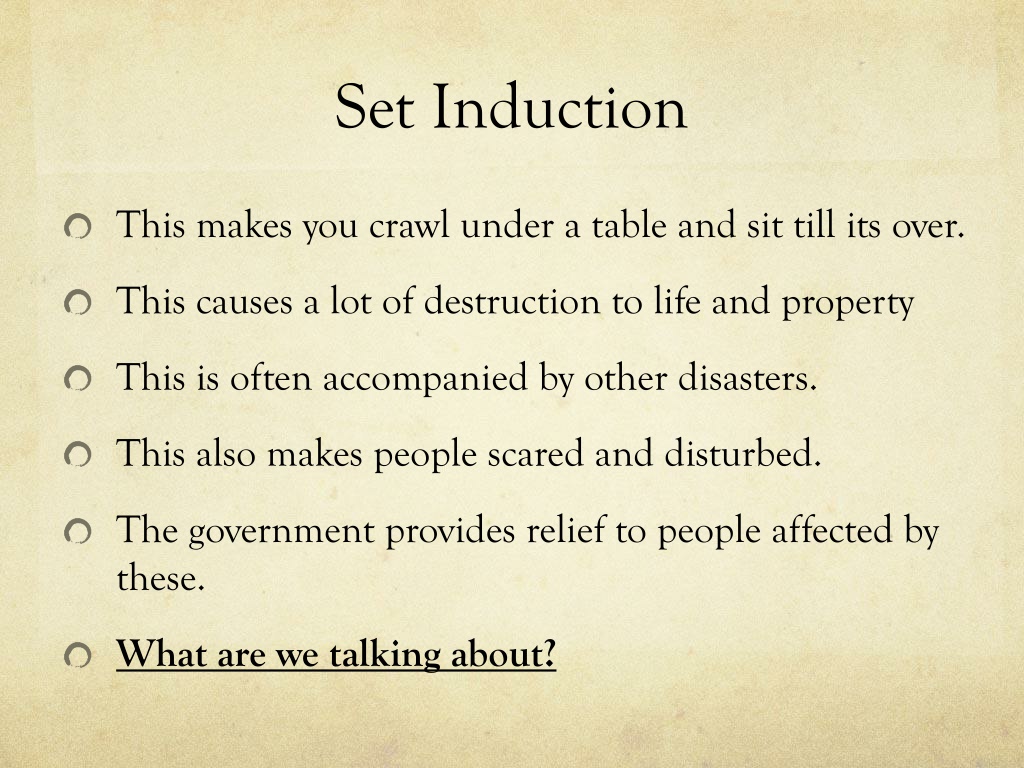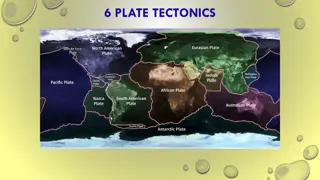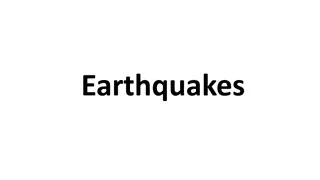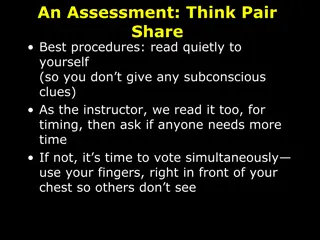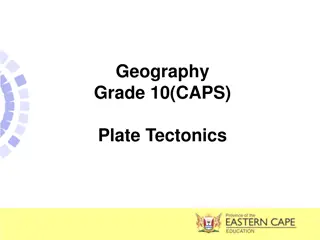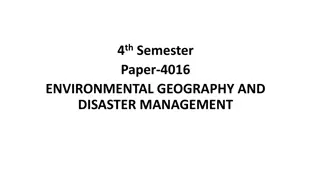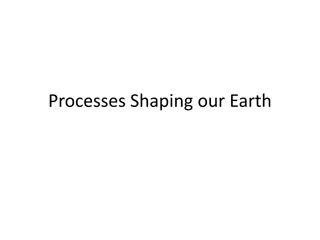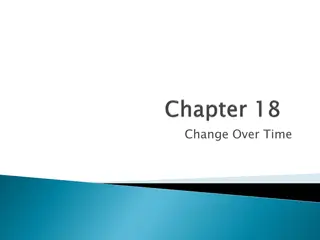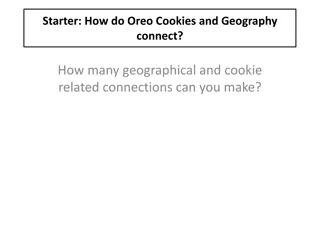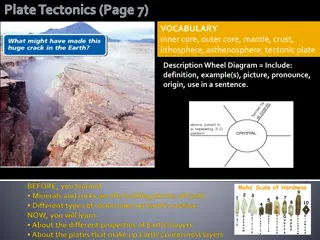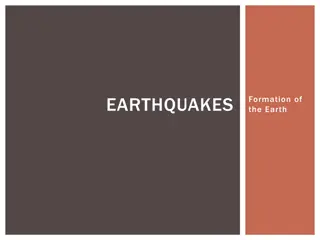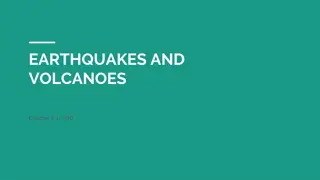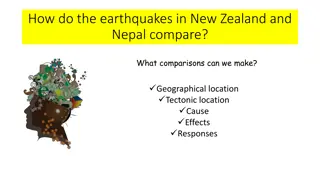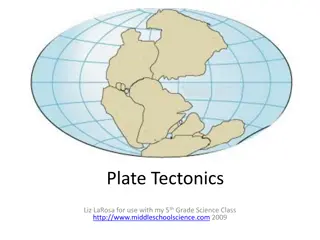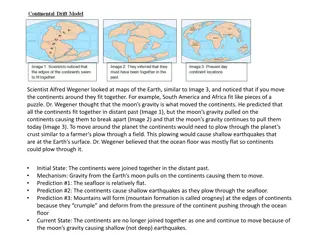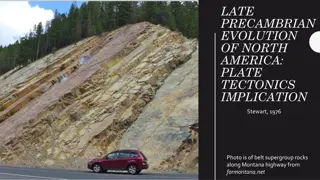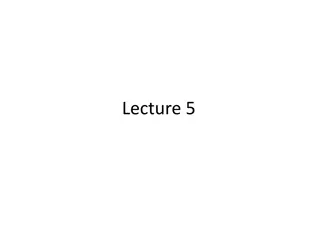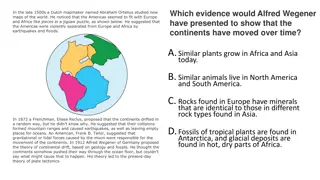Understanding Earthquakes and Plate Tectonics
Rapid Earth Movement, specifically earthquakes, is a natural disaster causing destruction and fear. Plate tectonics play a crucial role in the occurrence of earthquakes and volcanoes. The movement of Earth's plates at plate boundaries results in different geological features like fold mountains. This phenomenon is a result of the Earth's crust breaking into plates, causing rapid Earth movements with significant impacts on the environment.
Download Presentation

Please find below an Image/Link to download the presentation.
The content on the website is provided AS IS for your information and personal use only. It may not be sold, licensed, or shared on other websites without obtaining consent from the author. Download presentation by click this link. If you encounter any issues during the download, it is possible that the publisher has removed the file from their server.
E N D
Presentation Transcript
Set Induction This makes you crawl under a table and sit till its over. This causes a lot of destruction to life and property This is often accompanied by other disasters. This also makes people scared and disturbed. The government provides relief to people affected by these. What are we talking about?
EARTHQUAKES!! RAPID EARTH MOVEMENTS
Highlights: What are rapid earth movements? Specifications of earthquakes: 1. Primary Waves 2. Secondary Waves 3. Surface Waves 4. Epicenter/ Focus The two different rapid earth movements are Earthquakes & Volcanoes
Plate Tectonics The Earth's crust is broken up into pieces called plates. Heat rising and falling inside the mantle creates convection currents generated by radioactive decay in the core. The convection currents move the plates. Where convection currents diverge near the Earth's crust, plates move apart. Where convection currents converge, plates move towards each other. The movement of the plates, and the activity inside the Earth, is called plate tectonics.
Plate Boundaries Plate tectonics cause earthquakes and volcanoes. The point where two plates meet is called a plate boundary. Earthquakes and volcanoes are most likely to occur either on or near plate boundaries. Different plate boundaries At a tensional, constructive or divergent boundary the plates move apart. At a compressional, destructive or convergent boundary the plates move towards each other. At a conservative or transform boundary the plates slide past each other..
Fold Mountains As the plates push together, the continental crust is squashed together and forced upwards. This is called folding. The process of folding creates fold mountains. Fold mountains can also be formed where two continental plates push towards each other. This is how mountain ranges such as the Himalayas and the Alps were formed.
RAPID EARTH MOVEMENT a large-scale and sudden release of energy in the interior of the earth results in Rapid Earth Movement. High-speed Not long-lasting Often has far-reaching and destructive effects Vertical-radial direction Affects specific areas
EARTHQUAKE A sudden and violent shaking of the ground, as a result of the movement within the earth (along a faulty plane) is called an Earthquake. Earthquakes are caused by the release of built-up pressure inside the Earth's crust. An earthquake's power is measured on the Richter scale using an instrument called a 'seismometer'. The effects of an earthquake can be devastating - they can destroy settlements, change landscapes, and cause many deaths.
Felt and not felt. Earthquakes measuring just one or two on the scale are very common and can happen everyday in places like San Francisco. These earthquakes are so small that people cannot feel them, they can only be picked up by a seismometer. Earthquakes measuring around 7 or 8 on the Richter scale can be devastating. The earthquake in China's south-western Sichuan province in May 2008 measured 7.8 on the Richter scale.
Causes Earthquakes occur when tension is released from inside the crust. Plates do not always move smoothly alongside each other and sometimes get stuck. When this happens pressure builds up. When this pressure is eventually released, an earthquake tends to occur. The point inside the crust where the pressure is released is called the focus. The point on the Earth's surface above the focus is called the epicentre. Earthquake energy is released in seismic waves. These waves spread out from the focus. The waves are felt most strongly at the epicentre, becoming less strong as they travel further away. The most severe damage caused by an earthquake will happen close to the epicentre.
Important Earthquake Terms Focus The point of friction between two plates or the point of origin of the earthquake, below the earth s surface. The primary and secondary waves come from this point. Epicenter The point directly above the focus, on the earth s surface. It is also the point from which the surface waves emanate.
Primary waves the first of the seismic waves to hit the earth. They are the fastest and can travel through solid, liquid and gas. They travel through the interior of the earth.
Secondary waves they come after the primary waves, at almost half the speed of primary waves. They can travel only through solid and also move through the interior of the earth.
Surface Waves They begin at the epicenter and are the slowest of the lot and the most destructive. They travel through the surface of the earth, in a rolling/ wave-like fashion and sideways, like the secondary waves.
Factors affecting the impact of an earthquake Distance from the epicentre - the effects of an earthquake are more severe at its centre. The higher on the Richter scale, the more severe the earthquake is. Level of development (MEDC or LEDC) - MEDCs are more likely to have the resources and technology for monitoring, prediction and response. Population density (rural or urban area). The more densely populated an area, the more likely there are to be deaths and casualties.
Factors contd. Communication - accessibility for rescue teams. Time of day influences whether people are in their homes, at work or travelling. A severe earthquake at rush hour in a densely populated urban area could have devastating effects. The time of year and climate will influence survival rates and the rate at which disease can spread.
Effects of an earthquake Earthquakes can destroy settlements and kill many people. Aftershocks can cause even more damage to an area. It is possible to classify the impacts of an earthquake, by taking the following factors into account: short-term (immediate) impacts long-term impacts social impacts (the impact on people) economic impacts (the impact on the wealth of an area) environmental impacts (the impact on the landscape)
Effects of an earthquake- Effects are often classified as primary and secondary impacts. Primary effects occur as a direct result of the ground shaking, eg buildings collapsing. Secondary effects occur as a result of the primary effects, eg tsunamis or fires due to ruptured gas mains.
The effects of an earthquake or a volcano in LEDCs Communication systems may be underdeveloped, so the population may not be well educated about what to do in the event of a volcanic eruption or an earthquake. Construction standards tend to be poor in LEDCs. Homes and other buildings may suffer serious damage when a disaster occurs. Buildings collapsing can cause high death tolls. Evacuation and other emergency plans can be difficult to put into action due to limited funds and resources. Clearing up can be difficult. There may not be enough money to rebuild homes quickly and safely. Many people could be forced to live in emergency housing or refugee camps.
Case studies - Kobe, Japan, 1995 (MEDC) On 17th January 1995, an earthquake struck Kobe, a heavily populated urban area in Japan. It measured 7.4 on the Richter scale and occurred as a result of plate movement along the boundary between the Philippines Plate, Pacific Plate and Eurasian Plate. Effects Primary effects happen immediately. Secondary effects usually occur as a result of the primary effects.
Effects Responses
Kashmir, Pakistan, 2005 (LEDC) On 8 October 2005, an earthquake measuring 7.6 on the Richter scale hit the Kashmir region of Pakistan. The earthquake was the result of collision between the Indian and Eurasian plates.
Evaluation: 1. What are surface waves? 2. What is the difference between focus and epicenter? 3. Look at the map and locate the highest earthquake-affected area.
Home Assignment Show the different parts/ specifications of an earthquake through a diagram of the earth s crust.
Volcanoes As the plates move apart (very slowly), magma rises from the mantle. The magma erupts to the surface of the Earth. This is also accompanied by earthquakes. When the magma reaches the surface, it cools and solidifies to form a new crust of igneous rock. This process is repeated many times, over a long period of time. Eventually the new rock builds up to form a volcano. Constructive boundaries tend to be found under the sea, eg the Mid Atlantic Ridge. Here, chains of underwater volcanoes have formed along the plate boundary. One of these volcanoes may become so large that it erupts out of the sea to form a volcanic island, eg Surtsey and the Westman Islands near Iceland.
At a compressional or destructive boundary the plates are moving towards each other. This usually involves a continental plate and an oceanic plate. The oceanic plate is denser than the continental plate so, as they move together, the oceanic plate is forced underneath the continental plate. The point at which this happens is called the subduction zone. As the oceanic plate is forced below the continental plate it melts to form magma and earthquakes are triggered. The magma collects to form a magma chamber. This magma then rises up through cracks in the continental crust. As pressure builds up, a volcanic eruption may occur. The diagram below shows how the oceanic plate is pushed underneath the continental plate, causing mountains and possibly volcanoes to form along the destructive plate boundary.
